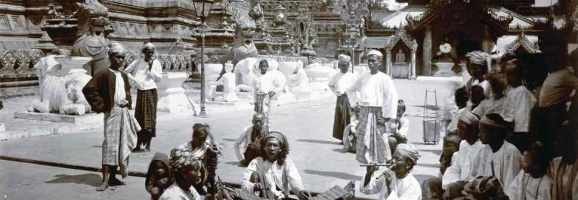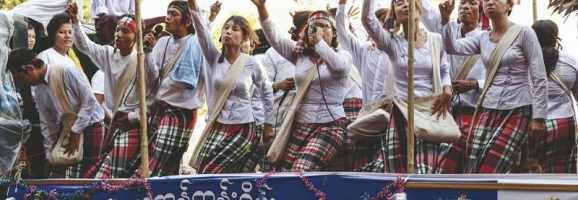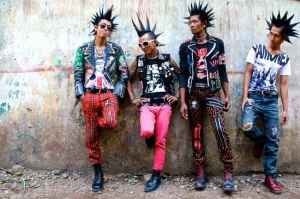Burmese Protest Music: A Brass Key to a Once Locked Nation

It is clear through the turbulent history of Burma, that oppression and censorship has taken a severe toll on the social and civil liberties of the Burmese people in recent years. As seen around the world in countries like Morocco and South Africa, music can and has the ability to allow oppressed citizens to express their grievances in a way that is tough to stifle and censor by the government. This has especially been the case in Burma, predominantly through the youth. Around one-third of the Burmese population is between the ages of 15-24. Therefore youth movements, like the musical movements of rap, pop, and punk are especially important and influential. Through the spread of music and its incognito lyrics and radical melodies and instrumentation, the citizens of Burma are beginning to slowly break free from the oppressing government.
Ancient Roots
The beginnings of Burmese protest music stem way before the arrival of the military junta dictatorship. Before the overtaking of Burma, the Burmese had an annual tradition called Thangyat, which was a new year celebration where they sang songs and performed skits that gave voice to local grievances. Thangyat coincided with Thingyan, the annual Burmese water festival. Traditional Thangyat music consists of songs that involve a call and response aspect. A lead singer sings or speaks a verse, which is then repeated or responded to by the other members of the band and audience. This aspect of the music is pivotal in garnering unity and understanding between the artist and audience. Therefore Thangyat music was the premier outlet for people and artists to join and air out problems and dilemmas they had faced throughout the year.
The tradition was banned in 1988, a year in which the military junta killed over 3,000 people in a series of democracy demonstrations. After banning this tradition, the junta began threatening jail for any musician who failed to obey this ban. Thangyat could not be stopped by the authorities as the music still continues to be created today. Rather than recording their music in Burma, musicians took their music overseas and to nations bordering Burma where they recorded music and sent it back to the Burmese people through the smuggling of mix tapes and CDs. Since the ban of Thangyat in 1988, exiled musicians have released more and more albums filled with songs and poetry commenting on the oppression and injustices committed by the military government. Many of the Thangyat songs condemn the rigged elections, the current poverty, and censorship.
The banning of Thangyat has become a clear example of ways the military junta is cracking down on the Burmese people and their freedoms. The tradition of Thangyat was practiced for decades before the military junta came into power, and this ban has implanted even more anger and frustration in the Burmese people. Win Tin, senior leader of the National League of Democracy, has said “Banning Thangyat during the is like closing and gagging a country’s eyes, ears and mouth. Really, it is like closing people’s hearts. Thangyat has been in Burmese society for many years.” Artists have also felt the tolls of a Thangyat-less Burma and have realized the effect the ban has taken on their freedom of expression. Godzilla, a famous Burmese Thangyat comedian, said ‘Thangyat is the outlet of the people’s sufferings and feelings in their hearts. They express their feelings in this form. The deeper their resentment the better their Thangyat will be.” Through this overarching ban on musical expression, the Burmese citizens have taken new and sometimes radical paths to bring back musical expression and fill the void that the ban of Thangyat has left.

The New Age of Music
One cannot delve into the protest music of Burma without first taking a look into the pop music scene. Pop music in Burma is by far the most listened to genre of music and the most popular and widespread. The pop music scene is producing national stars and hits at an unprecedented rate. Heather MacLachlan of the University of Dayton took a deep look into the Burmese pop scene and observed many key aspects. According to her field research, many of the Burmese pop sensations produce what are known as “copy songs”or songs almost identical to American pop songs. In Burma you can hear the hits of Shakira and Celine Dion sung in Burmese. Burmese pop music is not just limited to “copy songs,” as many artist produce their own music, sampling Western pop instrumentation and sound.
The immense popularity of pop music in Burma has definitely garnered significant attention by the military junta. Originally, the junta had banned pop music because of its deviation from traditional music. But in the 1970’s, they realized the popularity of the music and began using it as propaganda. The junta enlisted many artists to write songs that were pro-government and used pop music for public service announcements. According to MacLachlan, many Burmese pop artists walk a fine line when it comes to working for the government. Most people believe that recording music for the Burmese government is considered “selling out.” But in a country where music deviating from the set rules of the censor board can lead to jail time, “selling out” may be a pop musician’s only option.
Due to the strict censorship in Burma, any music that could be considered “illegal” or “anti-junta” must be played underground. All underground music that talks about the issues pressing Burma has to be performed and played in spaces and venues hidden throughout the country, especially in the city of Yangon. Due to the fact that music must pass through a censor board where lyrics are analyzed for underlying message, the rebellious movements of Punk and Rap must evade government censors. The clearest case of this situation lies in the Punk movement in Burma.
The Punk Movement
If there is any single musical movement that showcases protest in Burma, it is punk music. By looking at these punk artists, one can see the drastic deviation from traditional Burmese culture. This counter-culture is the leading movement of musical protest in Burma and showcases a clash between old vs. new and traditional vs contemporary. Most of the Burmese punk bands are creating and writing music with lyrics talking about oppression, censorship, and the poverty. The bands perform in abandoned buildings around the country, especially in Rangoon, and only members of the scene are granted entry into their concerts. Invisibility is a key aspect in the punk movement, as it is heavily banned by the government. To showcase the effectiveness and expression of the punk movement, we must delve deeper into one of the most popular punk bands in Burma, Rebel Riot.
The punk band Rebel Riot was formed after the controversial crackdown on the Saffron Revolution which resulted in a massacre of many Burmese people by the military government. The influence for their music and ideology can be seen through the life of the founder and lead singer, Kyaw Kyaw. The 24-year-old, lives in a home-made with a conjugated metal roof and a fireplace as the only source of heat. He also works in a textile factory making only around $60 dollars a month. When asked about his reasons on joining this rebellious movement Kyaw Kyaw said,
“We young people in Burma have become punks to protest against the political and economic situation in our country.”
Therefore the band plays music to express this protest. Rebel Riot performs in styrofoam lined buildings throughout the city of Rangoon, in front of hundreds of fellow punk members. They perform concerts only to members of the punk scene because any government officials in attendance could cause everyone participating to be arrested. Due to the band’s inability to record music through a government sponsored recording studio, Rebel Riot has followed the path of many Burmese musicians and posted their music on websites like Facebook, Myspace, and Reverbnation. Using the internet has helped Rebel Riot gain a larger fan base and create music, free from censors. When asked about the censorship of music, Kyaw Kyaw stated, “If I want to write something about freedom, if I want to write about the things I want, I can´t write it directly, it becomes political then.” The rebellion towards the oppressive regime and the fight to gain better conditions is readily evident in Rebel Riots music and lyrics. In their song titled “Lowest Class in Burma,” they speak about raging against the oppressors, stating that “human rights don’t apply to us,” and saying “we are victims, victims, victims.” Through their music and the many punk bands in Yangoon and surrounding cities, the cap on musical expression is slowly breaking.

Hip Hop
Similar to integral bands like Rebel Riot in the punk scene, there are many influential rap artists in Burma who are breaking new ground in music and in musical protest. One of these pioneers is Thar Zoe, whose stage name is Thxa Zoe. Through his new styles of controversial music, Zoe had begun to form a new movement of censor-evading rap. Thar Soe became involved with music when his father gifted him a cassette player. He was fascinated by western music and hip-hop and formed an underground hip-hop group with his friend when he was in 7th grade. His musical awakening came in the early 1990s, when a friend of his smuggled him cassettes of Vanilla Ice and M.C. Hammer. After hearing the influential western rap musicians he decided to attend the School of Audio Engineering Institute in London in 2001. Following his education, his goal was to bring electronic music to Myanmar and mix it with traditional Burmese Nat-Doe (the music of the spirits).
Thar Soe’s music has drastically changed over his career as a musician. Following his graduation, Soe returned to Burma and began using samples of classical Nat-Doe music and mixing it with electronic and pop music to create dance remixes. This music became very popular with the younger people of Burma but was also very controversial. Soe received a lot of trouble from the government censor board and the practice of mixing traditional and contemporary music was banned by the Habin Asiayone (Myanmar Theatre Association). This ban caused Soe to change the way he created music and showcases a key example of a musician circumventing the censorship place by the government. Soe began to create his own music and use electronic instruments that simulated traditional Burmese instruments. Although this circumvention was successful to a point, Soe’s lyrics have still fallen to the censor board. Many of his songs have been banned for a few words or phrases, deemed “offensive.” One of his most recent songs was banned because it had the lyrics: “Hey hey, how are you?” The Burmese government banned all 12 tracks on his most recent album claiming he had disrespected traditional Burmese music.
The protest and messages in his music can be clearly seen to comment on the tolls Burmese people face and the injustices that occur. For example, one of Thar Soe’s most famous songs is titled “Water, Electricity, Please Come Back,” which is an obvious comment on the inconsistent resources in Rangoon. He also has other songs called “Wake Up” which was urging young people to join the pro-democracy movement, and” Khwin Pyu Dot May (Please Excuse Me)” which is the story of a young man asking his mother to join the rebellion. Through a very large fanbase, politically driven music, and censor evading tactics, Thar Soe is a perfect example of how protest music is beginning to shape a revolution against the oppressing government.
In Burma there is only one other hip-hop artist who has as much influence and a vast fan base like Thar Soe. That artist is Zayar Thaw, a hip-hop musician and politician who is renowned for his politically pointed lyrics and influence on the Burmese hip-hop movement. Zayar Thaw began hip-hop when he formed the first hip-hop group in Burma called Acid. Acid’s music was very influential and their lyrics held politically heated commentary against the military junta. Their lyrics were shaped in various ways to avoid censorship and detection. Throughout his career, Thaw produced music mainly focused on the daily struggles of the Burmese people. Eventually, after releasing numerous banned tracks through Acid and his solo career, Thaw was jailed for 5 years because of his “rebel music.”
After his detainment, Thaw saw the realization and power of his music. With this knowledge, Thaw along with other Burmese protest musicians, including Thar Soe, formed a group called Generation Wave. Generation Wave is a group of young Burmese who are dedicated to rebelling the current government and overcoming the oppression they face through the spread of music. The Generation Wave artists record music underground, releasing tracks online in a wide array of genres to appeal to the majority. Although the payoff has been great, with influential music reaching the ears of many Burmese, participating in protest music and Generation Wave has been very dangerous. To date, over 50 Generation wave members have been jailed by the censor board and military junta. Through this music and movement, artists are slowly spreading their music from the underground studios of Burma to public ears, with the goal of sparking a revolution and gaining freedom from political injustices.
Progress towards creative and political freedom
From the politically unstable and violent history of Burma, freedom has not been experienced by the majority of Burmese citizens. Today, Burma trails just North Korea in terms of government censorship and lack of political freedoms. But in a world that is booming with technological advances, the Burmese people are finding new ways to slowly rebel and fight the oppression they face. By using music as a medium of protest, the Burmese are slowly finding their ways to break out of the current doxic shell and progress into a free nation. Through the ingenious tactics of artists in the punk, pop, and hip-hop movements, the Burmese citizens are beginning to see the light outside of oppression and the continuation of these movements will lead the people of Burma to a bright, free future.
What do you think? Leave a comment.











Burma has a history of revolutionary music for sure.
Thangyat!
Always interesting to read about musical protest that influences revolutions through complex and confrontational times.
Sheel, thank you for sharing this cultural piece.
Nice to see politics be challenged like this.
The future holds an active role for artists in the mobile protest of performance art in Myanmar.
Nice look at the colorful (and political) members of an emerging counterculture.
Protests have been used as a tool against corruption in Myanmar for centuries, and in the last 50 years, their effects has definitely been powerful.
Fabulous article, Sheel. The connections you make between rap, hiphop, and contemporary protest music are completely on point. Well done!
More than ever before, the performance of protest is used to deem societies! Great work by these musicians.
Interesting article considering that the junta is once again in power.